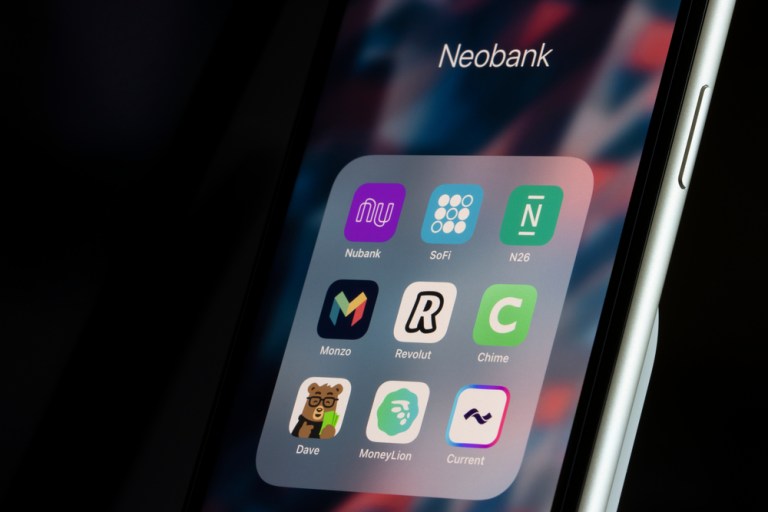
For platforms and neobanks, establishing direct deposits with end users offers an on-ramp to cross-selling opportunities and a wealth of additional revenue streams.
The momentum has been underscored in recent earnings reports and announcements surrounding new products and services.
The automated transfer of funds into those accounts — often through an accountholder’s paycheck — offers a dependable base upon which build those new offerings, and to cement users’ loyalties as these providers build out their respective financial ecosystems spanning deposits, lending and investing.
The push comes as PYMNTS Intelligence has found that fewer than 10% of consumers use FinTechs as their primary bank.
During SoFi’s most recent earnings call, CEO Anthony Noto said member acquisition and cross-selling is fueling “financial growth for years to come. Our one-stop shop strategy continues to deliver strong, diversified growth and profitability, despite macroeconomic volatility.”
The company’s earnings presentation and commentary noted that SoFi Money achieved new records during the second quarter as ending deposits totaled $23 billion. Consumer deposits were up $2.2 billion from the previous quarter. Account openings grew by 419,000 and 90% of the company deposits remain tied to what Noto termed “sticky direct deposit relationships.”
Lending products increased 19% year over year to 1.8 million products, driven primarily by continued demand for personal loan products as well as what Noto said was “steady growth in student and home loan products.” Consumer loan originations were $1.8 billion in the latest quarter, up from the $1.6 billion in the first quarter.
LendingClub, in its own filings and quarterly reports, notes that with its “FDIC-insured high-yield savings account, members can enhance their savings by earning competitive interest on their entire balance,” including direct deposit activity, where management has noted that overall deposits have topped $7.5 billion. LendingClub, of course, expanded its banking reach and presence through its 2020 acquisition of Radius Bank.
In the latest quarter, management observed that the mobile/digital channels help foster a continuum of engagement, as CEO Scott Sanborn said that “with self-service functionality in the first phase of our comprehensive debt monitoring and management solution embedded in the app, mobile users are finding more reasons to engage with us. In fact, they’re logging in about 20% to 25% more often than web-only users, providing a growing, active, and engaged audience for communicating new offers and services.”
In past earnings coverage, we noted that current and upcoming company initiatives include a greater emphasis on giving members additional financial wellness tools, including debt monitoring solutions being tested with select members that will have broader rollouts. Present tests reveal that enrolled members “with visibility into their credit profiles, current debt and cost of that debt,” are visiting LendingClub up to 50% more often than those not enrolled, Sanborn said during the first-quarter call.
Sanborn also stated during the first-quarter commentary that there will be “turnkey embedded finance” functionalities that are being tested and will allow, in Sanborn’s words, “digital delivery of personalized, prescreened loan offers” via advertisers and with integration with several, select partners by the end of 2024.
Chime is not publicly traded (and has been reported to be mulling an IPO next year), but recent announcements spotlight ancillary services and products tied to checking accounts, as direct deposits remain a centerpiece. As detailed here, Chime is adding an earned wage access offering called MyPay to its banking app.
With MyPay, qualifying Chime members will be able to access between $20 and $500 of their pay before payday during each pay period, depending on their limit that is based on estimated income and risk-based criteria, according to the release.
Members can choose to have the funds deposited to their Chime checking account within two days for free or to get the funds instantly for a $2 fee, per the release.
Elsewhere, Block’s earnings show that direct deposit remains a strategic imperative. CEO Jack Dorsey said on the conference call with analysts that “there’s three main ways that we believe we will drive direct deposit, and this is all captured in our bank-the-base strategy … the first is packaging. The second is around marketing, and the third is products. I’ll start with packaging.”
The consumers who deposit $300 each month get access to free overdraft coverage up to a certain amount, and a 4.5% savings yield, said Dorsey, who added that the company is “cross-selling direct deposit through in-app messages as well, as “we want to add spending insights to the Cash App Card, so customers can make more informed financial decisions, improving our web experience to look at balances and review statements.”
The company added in its earnings materials that the number of Cash App Card monthly actives in June increased 13% year over year to more than 24 million and spend per monthly active also grew on a year-over-year basis.
“Paycheck deposit monthly actives as of June grew quarter over quarter compared to March,” per Block’s disclosures.
Monzo, busy expanding its U.S. presence, said late last month that interest rates on money saved in its Monzo Jars would top 4.2%, for consumers depositing their paychecks with Monzo.